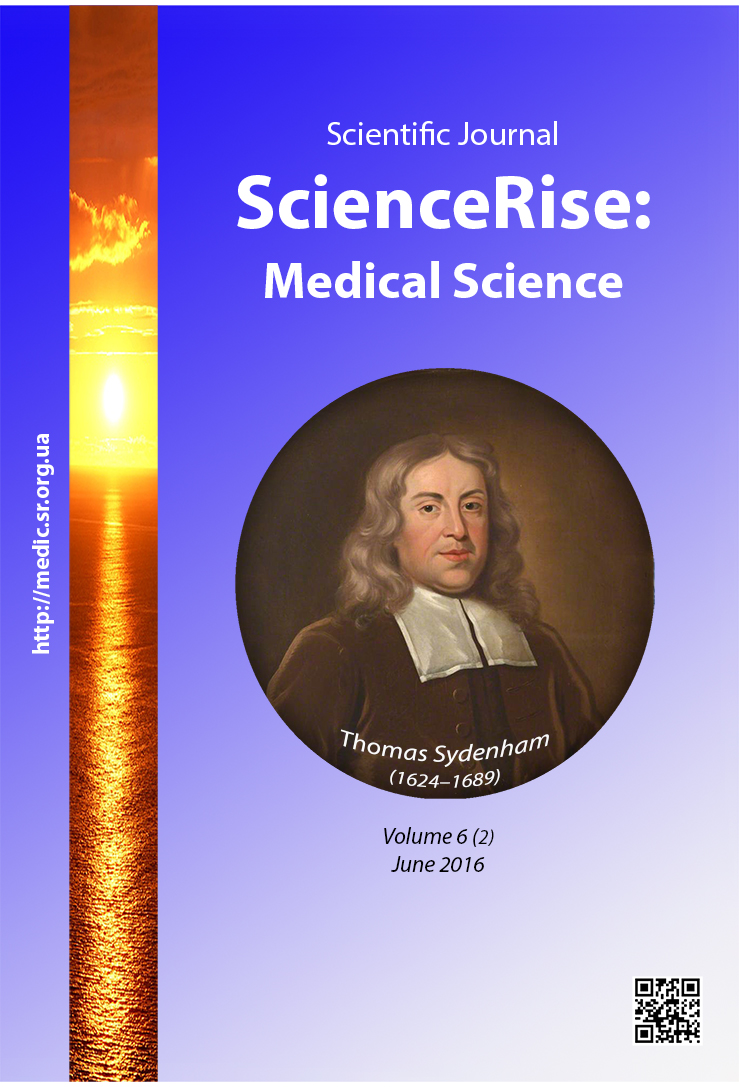Peculiarities of microvasculature condition in patients with traumatic brain injury consequences
DOI:
https://doi.org/10.15587/2519-4798.2016.72719Keywords:
traumatic brain injury, consequences, microvasculature, capillary, apoptosisAbstract
The aim of the given research was to analyze peculiarities of microvasculature condition in patients with traumatic brain injury (TBI) consequences and to determine its influence on traumatic brain disease course.
Methods. The assessment of the microvasculature structural characteristics (total capillary length; the arterial and venous links length, caliber, tortuosity factor and tone; perivascular edema value) was carried out in 103 patients with TBI consequences using capillaroscopy method with Angio Pro software. Neurological status was evaluated by Neurological Outcome Scale for Traumatic Brain Injury (NOS-TBI), cognitive condition – by Montreal Cognitive Assessment (MoCA), level of anxiety and depression – by HADS scale. The percentage of peripheral blood leukocytes in the apoptosis (АnV+) and necrosis (РІ+) stages, as well as reactive oxygen species (ROS+) level were studied using flow cytometry method.
Results. Increased tortuosity coefficient of arterioles and venules, increased arteriolar tone, and a tendency for venules lumen to expand with formation of venous stasis phenomena and moderately pronounced signs of perivascular edema were diagnosed in patients with different severity of TBI consequences. The relationship between morphological and clinical parameters intensified in older age groups. Thus, in adult patients the cognitive functioning level (by MoCA test) depended on the capillary total length (r=0,416, р=0,002), and tortuosity coefficient of arterioles was higher under conditions of progressing disease (r=0,301, р=0,027) and several syndromes combination in the clinical picture (r=0,317, р=0,019).
Conclusion. Stagnant microcirculation type with moderate perivascular edema signs formation is inherent in patients with TBI consequences. ROS+ concentration increasing adversely affected the capillary length and contributed to perivascular edema growth. The share of leukocytes in necrosis and apoptosis stages correlated moderately with tortuosity coefficient of arterioles and venules
References
- Willemse-van Son, A., Ribbers, G., Hop, W., Stam, H. (2009). Community integration following moderate to severe traumatic brain injury: A longitudinal investigation. Journal of Rehabilitation Medicine, 41 (7), 521–527. doi: 10.2340/16501977-0377
- Corso, P. (2006). Incidence and lifetime costs of injuries in the United States. Injury Prevention, 12 (4), 212–218. doi: 10.1136/ip.2005.010983
- Moroz, V. V., Churyaev, Ju. A. (2006). Vtorichnyie povrezhdeniya golovnogo mozga pri tyazheloy cherepno-mozgovoy travme [Secondary brain damage in severe traumatic brain injury]. Moscow: Medicina, 403.
- Farkas, E., de Vos, R. A. I., Donka, G., Jansen Steur, E. N., Mihály, A., Luiten, P. G. M. (2006). Age-related microvascular degeneration in the human cerebral periventricular white matter. Acta Neuropathologica, 111 (2), 150–157. doi: 10.1007/s00401-005-0007-y
- Brown, W. R., Moody, D. M., Thore, C. R., Challa, V. R., Anstrom, J. A. (2007). Vascular dementia in leukoaraiosis may be a consequence of capillary loss not only in the lesions, but in normal-appearing white matter and cortex as well. Journal of the Neurological Sciences, 257 (1-2), 62–66. doi: 10.1016/j.jns.2007.01.015
- Wolin, M. S. (2009). Reactive oxygen species and the control of vascular function. AJP: Heart and Circulatory Physiology, 296 (3), H539–H549. doi: 10.1152/ajpheart.01167.2008
- Luschik, U. B., Novitskiy, V. V., Kolosova, Yu. A., Alekseeva, T. S. (2004). Sovremennyie vozmozhnosti kapillyaroskopii [Modern possibilities Capillaroscopy]. Kiev: NMCUZMD Istina, 52.
- Wilde, E. A., McCauley, S. R., Kelly, T. M., Levin, H. S., Pedroza, C., Clifton, G. L. et. al (2010). Feasibility of the Neurological Outcome Scale for Traumatic Brain Injury (NOS-TBI) in Adults. Journal of Neurotrauma, 27 (6), 975–981. doi: 10.1089/neu.2009.1193
- MoCA. Available at: http://www.mocatest.org/
- Bjelland, I., Dahl, A. A., Haug, T. T., Neckelmann, D. (2002). The validity of the Hospital Anxiety and Depression Scale. Journal of Psychosomatic Research, 52 (2), 69–77. doi: 10.1016/s0022-3999(01)00296-3
- Brown, W. R. (2010). A review of string vessels or collapsed, empty basement membrane tubes. Journal of Alzheimer’s Disease, 21 (3), 725–739. doi: 10.3233/jad-2010-100219
- Chibber, R., Ben-Mahmud, B., Chibber, S., Kohner, E. (2007). Leukocytes in Diabetic Retinopathy. Current Diabetes Reviews, 3 (1), 3–14. doi: 10.2174/157339907779802139
Downloads
Published
How to Cite
Issue
Section
License
Copyright (c) 2016 Зоя Василівна Салій

This work is licensed under a Creative Commons Attribution 4.0 International License.
Our journal abides by the Creative Commons CC BY copyright rights and permissions for open access journals.
Authors, who are published in this journal, agree to the following conditions:
1. The authors reserve the right to authorship of the work and pass the first publication right of this work to the journal under the terms of a Creative Commons CC BY, which allows others to freely distribute the published research with the obligatory reference to the authors of the original work and the first publication of the work in this journal.
2. The authors have the right to conclude separate supplement agreements that relate to non-exclusive work distribution in the form in which it has been published by the journal (for example, to upload the work to the online storage of the journal or publish it as part of a monograph), provided that the reference to the first publication of the work in this journal is included.









